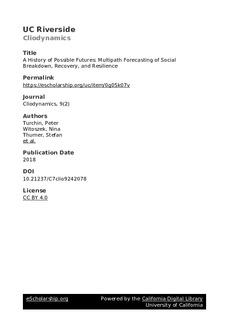| dc.contributor.author | Turchin, Peter | |
| dc.contributor.author | Witoszek, Nina | |
| dc.contributor.author | Thurner, Stefan | |
| dc.contributor.author | Garcia, David | |
| dc.contributor.author | Griffin, Roger | |
| dc.contributor.author | Hoyer, Daniel | |
| dc.contributor.author | Midttun, Atle | |
| dc.contributor.author | Bennett, James | |
| dc.contributor.author | Næss, Knut Myrum | |
| dc.contributor.author | Gavrilets, Sergey | |
| dc.date.accessioned | 2019-02-26T12:10:51Z | |
| dc.date.available | 2019-02-26T12:10:51Z | |
| dc.date.created | 2019-01-07T14:41:06Z | |
| dc.date.issued | 2018 | |
| dc.identifier.citation | Cliodynamics. 2018, 9 (2), 124-139. | nb_NO |
| dc.identifier.issn | 2373-7530 | |
| dc.identifier.uri | http://hdl.handle.net/11250/2587456 | |
| dc.description.abstract | Recent years have seen major political crises throughout the world, and foreign policy analysts nearly universally expect to see rising tensions within (and between) countries in the next 5–20 years. Being able to predict future crises and to assess the resilience of different countries to various shocks is of foremost importance in averting the potentially huge human costs of state collapse and civil war. The premise of this paper is that a transdisciplinary approach to forecasting social breakdown, recovery, and resilience is entirely feasible, as a result of recent breakthroughs in statistical analysis of large-scale historical data, the qualitative insights of historical and semiotic investigations, and agent-based models that translate between micro-dynamics of interacting individuals and the collective macro-level events emerging from these interactions. Our goal is to construct a series of probabilistic scenarios of social breakdown and recovery, based on historical crises and outcomes, which can aid the analysis of potential outcomes of future crises. We call this approach—similar in spirit to ensemble forecasting in weather prediction—multipath forecasting (MPF). This paper aims to set out the methodological premises and basic stages envisaged to realize this goal within a transdisciplinary research collaboration: first, the statistical analysis of a massive database of past instances of crisis to determine how actual outcomes (the severity of disruption and violence, the speed of resolution) depend on inputs (economic, political, and cultural factors); second, the encoding of these analytical insights into probabilistic, empirically informed computational models of societal breakdown and recovery—the MPF engine; third, testing the MPF engine to “predict” the trajectories and outcomes of another set of past social upheavals, which were not used in building the model. This “historical retrodiction” is an innovation that will allow us to further refine the MPF technology. Ultimately our vision is to use MPF to help write what we call “a history of possible futures,” in which the near- and medium-term paths of societies are probabilistically forecast. | nb_NO |
| dc.description.abstract | A History of Possible Futures: Multipath Forecasting of Social breakdown, Recovery and Resilience | nb_NO |
| dc.language.iso | eng | nb_NO |
| dc.publisher | e Sholaryship | nb_NO |
| dc.relation.uri | https://escholarship.org/uc/item/0g05k07v | |
| dc.rights | Navngivelse 4.0 Internasjonal | * |
| dc.rights.uri | http://creativecommons.org/licenses/by/4.0/deed.no | * |
| dc.title | A History of Possible Futures: Multipath Forecasting of Social breakdown, Recovery and Resilience | nb_NO |
| dc.type | Journal article | nb_NO |
| dc.type | Peer reviewed | nb_NO |
| dc.description.version | publishedVersion | nb_NO |
| dc.source.pagenumber | 124-139 | nb_NO |
| dc.source.volume | 9 | nb_NO |
| dc.source.journal | Cliodynamics | nb_NO |
| dc.source.issue | 2 | nb_NO |
| dc.identifier.doi | 10.21237/C7clio9242078 | |
| dc.identifier.cristin | 1651662 | |
| cristin.unitcode | 158,12,0,0 | |
| cristin.unitname | Institutt for rettsvitenskap og styring | |
| cristin.ispublished | true | |
| cristin.fulltext | original | |
| cristin.qualitycode | 1 | |

